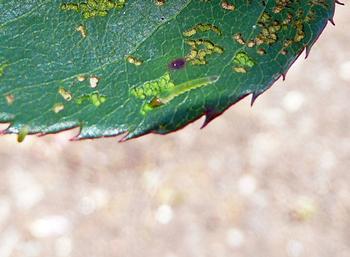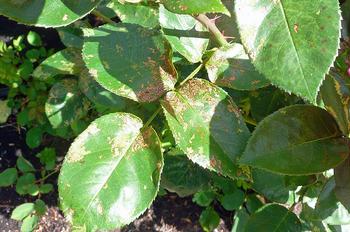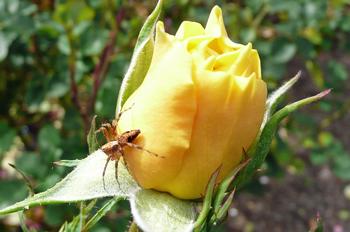What’s eating your rose leaves?
-
Nanette Londeree
-
May and June are glorious times in the garden; if you’re a rose lover, it’s when most roses are at their peak of bloom—nothing quite like a bush with beautiful blossoms framed by healthy green foliage to draw the eye. But wait – is the foliage surrounding your flowers looking more like leaf skeletons? Have leaves turned brown and dried up? What’s happening? Rose slugs may be the culprit.
 The rose sawfly deposits eggs on the edge of rose leaves. Photo: Nanette Londeree
The rose sawfly deposits eggs on the edge of rose leaves. Photo: Nanette LondereeRose slugs are the caterpillar-like larvae of a sawfly, a type of primitive stingless wasp. Adult sawflies are thick-waisted, about half-inch long, and mostly shiny black. They’re named for the female's saw-toothed egg-laying appendage that she uses to make cuts along the edges of rose leaves, inserting a single egg into each cut.
Sawflies go through multiple life stages. When eggs hatch, the larvae begin eating immediately, increasing in size until they fall to the ground. After wrapping themselves into a cocoon for protection, they develop into adults that emerge in spring, ready to mate. Depending on the species and situation, rose sawflies pupate in cocoons on leaves, in organic litter beneath plants, or in a cell in twigs or the stub end of cut roses and have one or more generations per year.
You might find three types of rose slugs - the bristly rose slug, the curled rose slug, and the common rose slug, also known as the American or European rose slug. Ranging in size from one-half to three-quarter inches long, they have a light, somewhat translucent green body, and a brownish-orange, well-developed head. They secrete a slimy substance over their body surface so that they resemble small slugs. However, they’re not caterpillars – they have more pairs of prolegs than caterpillars. While the three species are all similar in color and general appearance, the bristly rose slug is covered with bristle-like hairs, and the curled rose slug curls up when the body is at rest. The common Rose Slug chews the top surface of rose leaves. Photo: Nanette Londeree
The common Rose Slug chews the top surface of rose leaves. Photo: Nanette LondereeThese insects chew into the tender parts of a leaf between the veins, producing a skeletonized leaf, also known as windowpane-like damage. Young bristly rose slug larvae are generally found on the underside of rose leaves, while the older larvae chew holes right through leaves. All ages of the common rose slug larvae chew off and scrape the upper surface of leaves, but they don’t chew holes through the foliage. The curled rose slug chews entirely through leaves along the edges, leaving mostly veins. They may chew half-moon-shaped cuts in leaf edges, similar to leafcutting bees. Larvae of curled rose slugs ultimately chew into stems and form a pupation chamber in the pith.
The first signs of damage to foliage are usually seen in early to mid-May and can continue through mid-June. Affected areas on leaves dry up and become white or pale brown. Foliage may be unsightly, and when the numbers of pests are high, it may reduce subsequent blooming, though it doesn’t usually threaten the survival of otherwise-healthy roses. Areas that have been eaten by rose slugs turn brown and die. Photo: Nanette Londeree
Areas that have been eaten by rose slugs turn brown and die. Photo: Nanette LondereeMonitor your roses closely to prevent this pest from getting established in your garden, monitor your roses closely. As buds begin forming on plants, look for sawfly larvae on the leaves upper and lower surfaces of leaves. Handpick larvae or clip off and dispose of infested foliage if they are on a small portion of the plant.
Natural enemies keep many sawfly populations low. Birds, parasitic wasps, predaceous beetles, spiders, and small mammals commonly feed on and kill sawflies. Avoid pesticides, if possible, to allow beneficial species to aid in your control efforts.
If you choose to use an insecticide, begin with the least toxic - horticultural or narrow-range oil, insecticidal soap, or neem oil, making sure to coat both sides of the leaves. Bacillus thuringiensis (Bt) is ineffective against sawfly larvae since they are not caterpillars. Spiders are one of the natural enemies that can keep the rose slug population in check by preying on the adult sawfly. Photo: Nanette Londeree
Spiders are one of the natural enemies that can keep the rose slug population in check by preying on the adult sawfly. Photo: Nanette LondereeKeep observing your plants through the season and act quickly if you see any rose slug larvae. By doing so, you’ll be able to enjoy your beautiful rose blossoms surrounded by healthy green foliage.




